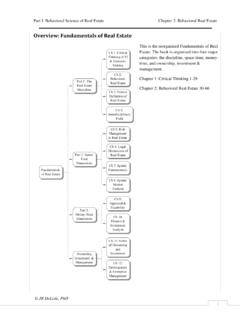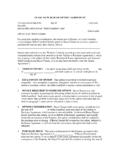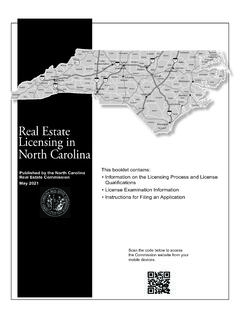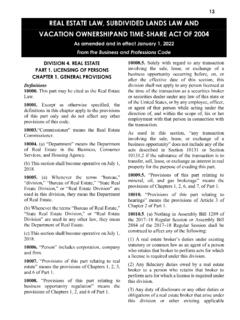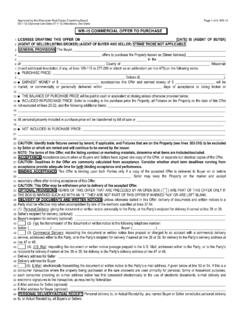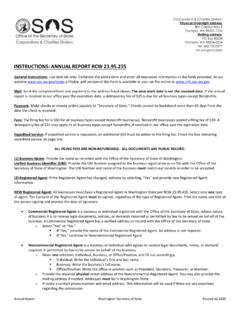Transcription of Smart buildings: How IoT technology aims to add real estate
1 Smart buildings: How IoT technology aims to add value for real estate companiesThe Internet of Things in the CRE industryAn article in Deloitte s series examining the nature and impact of the Internet of ThingsA research report from the Deloitte Center for Financial ServicesDeloitte s Internet of Things practice enables organizations to identify where the IoT can potentially create value in their industry and develop strategies to capture that value, utilizing the IoT for operational benefit. To learn more about Deloitte s IoT practice, visit more of our research and thought leadership on the IoT at Kejriwal is the real estate research leader at the Deloitte Center for Financial Services, where she is responsible for driving eminence and thought leadership for the real estate practice.
2 Prior to joining Deloitte, she led the captive credit research unit of Bank of America Merrill Lynch and tracked the investment grade real estate and homebuilders sectors. Among other publications, Surabhi has contributed significantly to the annual real estate industry Mahajan is an assistant manager, covering real estate at the Deloitte Center for Financial Services. Saurabh researches on a broad range of themes with a focus on technology and sustain-ability. Prior to joining Deloitte, he was a real estate equity analyst, specializing in financial model-ing, valuation, and investment advisory. About the authorsContentsEnhancing performance and reimagining tenant experience | 2 What is the IoT? | 4 The uses of the IoT: Far beyond motion-sensor lighting | 7 Where the value is: Leveraging IoT data | 9 Value capture: How to maximize IoT value?
3 | 17 Location, information, analytics or location, location, location? | 20 Appendices | 22 Endnotes | 24 Acknowledgements | 26 Contacts | 27 The Internet of Things in the CRE industry1 Enhancing performance and reimagining tenant experienceTECHNOLOGY is changing the most funda-mental truth about commercial real estate (CRE) that value is based solely on loca-tion, location, location. While it still matters, of course, that a space be close to customers, employees, and/or suppliers, information-based applications have the potential to add new ways for the CRE sector to create value for customers, differentiate from competitors, and even find new sources of revenue. Specifically, the Internet of Things (IoT) is already having a significant impact on the CRE industry, helping companies move beyond a focus on cost reduction.
4 IoT applications aim to grow margins and enable features such as dramatically more efficient building opera-tions, enhanced tenant relationships, and new revenue generation opportunities. Consider the increasingly popular Smart thermostats that intuitively adjust the temperature, humid-ity, and light based on residents preferences and climatic conditions. While consumer IoT devices have drawn most press attention, it is enterprise-level adoption of the technology that will likely have the bigger impact on industry. Indeed, the CRE industry is perhaps uniquely positioned to implement the technology , using IoT-enabled building management systems (BMS) to make building performance more efficient and also use sensor-generated data to enhance build-ing user experience.
5 Gartner s recent Smart -city forecasts highlight the potential: Smart commercial buildings will be the highest user of Internet of Things (IoT) until 2017, after which Smart homes will take the lead with just over 1 billion connected things in 2018. 1 This not only allows CRE to expose wide seg-ments of the population to IoT technology it provides owners an opportunity to have direct conversations and relationships with building users rather than only with their tenants. For instance, sensors in shopping malls can help owners connect directly and offer services to end customers. This would lead to build-ing relationships with customers as well as strengthening tenant engagement. Smart buildings: How IoT technology aims to add value for real estate companies2 The Internet of Things in the CRE industry3 THE IoT is a suite of technologies and appli-cations that equip devices and locations to generate all kinds of information and to connect those devices and locations for instant data analysis and, ideally, Smart action.
6 Conceptually, the IoT implies physical objects being able to utilize the Internet backbone to communicate data about their condition, posi-tion, or other (For more informa-tion on the technologies that power the IoT, see our primer, Inside the Internet of ) CRE companies may find it most relevant to understand how various types of sensors can track features such as motion, air pressure, light, temperature, and water flow and then with the Internet backbone enable the BMS to autonomously sense, communicate, analyze, and act or react to people or other machines in a nonintrusive manner (see figure 1). With the cost of sensors, data storage, and connectivity all falling,4 we expect more CRE firms to move forward in adopting IoT applica-tions.
7 A recent Deloitte Center for Financial Services study suggests that IoT technology What is the IoT?has huge potential in CRE: In fact, sensor deployment in the sector is likely to grow at a compound annual growth rate of per-cent between 2015 and 2020 (see figure 2 and appendix 1 2) to nearly such sensors, the IoT promises to turn any object into a source of information about that object and its environment. This creates both a new way to differentiate prod-ucts and services and a new source of value that can be managed in its own right. Realizing the IoT s full potential motivates a frame-work that captures the series and sequence of activities by which organizations create value from information: the Information Value Loop (see figure 3).
8 In the CRE context, the value created from the information generated by IoT-enabled buildings has the potential to widen the lens on value creation beyond location through a level of efficiency and effectiveness that could distinguish buildings within a marketplace from a desirability and profitability standpoint. Smart buildings: How IoT technology aims to add value for real estate companies4 Graphic: Deloitte University Press | : Jim Young, BIoT BUILDING Internet of Things , Realcomm, January 23, 2014; Deloitte Center for Financial Services analysis.*HVAC refers to heating, ventilation, and 1. IoT information value stack for CRE buildingsHVAC* Lighting Water Elevator Parking Waste Energy Standardized, secure, and integrated IP network Chemical sensorsLight sensors Temperature sensors Fire safetyOccupancy and motion sensors Ubiquitous analytic capabilitiesApplication interface accessible on mobileIntegrated platformDisparate building systemsAdvanced multiuse compatible sensorsAccess andsecurityFitnesstrackersOccupancymonit orsScalable cloud-basedanalytical abilitiesThird-party applicationsEnterprise % CAGR, 2015 20 Graphic: Deloitte University Press | : Chart created and analysis performed by the Deloitte Center for Financial Services based on Gartner research: Forecast.
9 Internet of Things, endpoints and associated services, Worldwide, 2015, Gartner Inc., October 29, 2015. For more information on categories and sensor types included in the graph, please refer to appendix 1. , 2. Potential growth in worldwide IoT sensor deployments for CRE (2015 20), millionsThe Internet of Things in the CRE industry5 THE INFORMATION VALUE LOOP For information to complete the loop and create value, it passes through the loop s stages, each enabled by specific technologies. An act is monitored by a sensor that creates information, that information passes through a network so that it can be communicated, and standards be they technical, legal, regulatory, or social allow that information to be aggregated across time and space.
10 Augmented intelligence is a generic term meant to capture all manner of analytical support, collectively used to analyze information. The loop is completed via augmented behavior technologies that either enable automated action or shape human decisions in a manner leading to improved : Deloitte University Press | : Deloitte Center for Financial 3. CRE Information Value LoopThe aggregated information can be analyzed through different analytical tools for descriptive, prescriptive, and predictive insights for building and unstructured data from different internal and external systems can then be aggregated through a common platform and/or a set of interoperable types of sensors that track features such as motion, pressure, light, temperature, and flow can collect a vast amount of data about building function, operations, and parts of the BMS can communicate with each other, which generates a new set of :Scale, scope, frequencyRisk:Security, reliability, accuracyTime.











